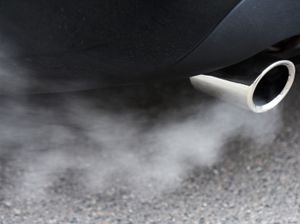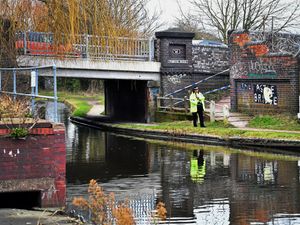Worst West Midlands pollution spots revealed
A "dangerous" part of Birmingham city centre has been named as the region’s worst air pollution hotspot.

Birmingham also holds six of the top ten sites for poor air quality across the wider West Midlands, including sites in Staffordshire and Worcestershire.
The worst part of the Black Country is Halesowen Road in Netherton, which came fourth on the list.
Friends of the Earth checked the most recent data submitted by English councils to the Department for Environment, Food and Rural Affairs (Defra) on sites which exceed safe air pollution levels.
The group checked sites measuring nitrogen dioxide (NO2) – a pollutant mainly caused by road traffic and burning fossil fuels, which increases the likelihood of illnesses such as lung disease when inhaled.
Wider West Midlands top ten
St Chads, Birmingham – 74ug/m3 (up from 61ug/m3 the year before)
Horsefair, Kidderminster, Worcs. – 68.5ug/m3 (59.6ug/m3)
Etruria Road, Basford, Stoke-on-Trent – 67.9ug/m3 (68ug/m3)
Halesowen Road, Netherton, Dudley – 66.5ug/m3 (69.3ug/m3)
Priory Queensway, Birmingham – 65ug/m3 (72ug/m3)
A50 Uttoxeter, Staffs. – 64.4ug/m3 (67.7ug/m3)
Islington Row, Birmingham – 63ug/m3 (66ug/m3)
Moor Street Quarter, Birmingham – 62ug/m3 (n/a)
Dartmouth, Birmingham – 60ug/m3 (61ug/m3)
Moor Street, Birmingham – 60ug/m3 (70ug/m3)
The work showed there are 1,360 sites across England where annual average concentrations of NO2 are higher than 40 micrograms per cubic metre.
This is the legal limit set by the EU and also the target set in the UK annual air quality objectives.
The figures – from submissions by councils covering 2018, the most recent available – show an improvement on the previous year across England when there were 1,591 breaches.
And there has also been an improvement in the average level among the ten worst performing sites across the wider West Midlands compared to the previous list.
The previous year’s survey showed that across the wider West Midlands, Coventry’s Holyhead Road had the worst annual average – 75.6 micrograms per cubic metre.
The latest figures show a site at St Chad’s Queensway in Birmingham city centre now takes the number one spot at 74 micrograms per cubic metre, up from 61 the year before.
The spot is among the top twenty highest annual averages across England, according to the group, with the highest levels being seen in West Dorset, Sheffield, Brighton, Leeds, London and Doncaster.
Birmingham City Council has previously stated up to 900 people per year die early in the city as a result of air pollution.
It has also said that "according to Defra modelling, the concentration of NO2 in Birmingham’s air is up to 50 per cent higher than it should be".
Chris Crean, campaigner for West Midlands Friends of the Earth, said: "Failing to fix air pollution costs lives.
"It also shows a failure to address the climate crisis because the sources and solutions are intrinsically linked.
"If ministers want to avoid a return to the health-damaging and illegal levels of air pollution we had before lockdown, their enthusiasm for ‘active travel’ needs to be a permanent switch and not just a short-term gap plugger.
"The Government must also end its damaging fixation on building more roads. You can’t justify this by planning to phase out polluting petrol and diesel vehicles and replace them with electric ones.
"We need to go much further than just getting out of one type of car and into another.
"Investment in better cycling and walking should be part of a fair and green post-coronavirus economic recovery plan aimed at creating a cleaner, fairer future.”
Campaign group Extinction Rebellion has demonstrated over air quality, recently staging a protest on top of Bristol’s City Hall over deaths in the city linked to air pollution.
Verel Rodrigues, campaigner at Extinction Rebellion Birmingham, said: "The amount of pollution in Birmingham’s air is at dangerous levels.
"This not only has appalling effects for the people of the city, but it is also contributes to the planetary climate and ecological emergency.
"During lockdown, we have seen that air quality CAN improve quickly. We must act now.”
The Birmingham clean air zone (CAZ) – due to be introduced in 2021 – is intended to address the issue, with higher-polluting cars intended to be charged for entering the city centre.
The CAZ forms a key part of the city council’s current air quality action plan consultation.
A Birmingham City Council spokesperson said: "This data is taken from our own air quality survey data, which we publish on an annual basis.
"Birmingham City Council’s plans to reduce levels of NO2 have been well documented.
"In 2021 we will launch the clean air zone, which will play a significant role in reducing the levels of NO2 to within the legal limit in the city centre.
"This week, we announced the publication of our draft air quality plan which sets out how we will improve air quality between 2020-2025.
"The plan prioritises identifying locations outside the clean air zone with persistently high nitrogen dioxide levels."
Friends of the Earth’s work is funded in part by the People’s Postcode Lottery.





